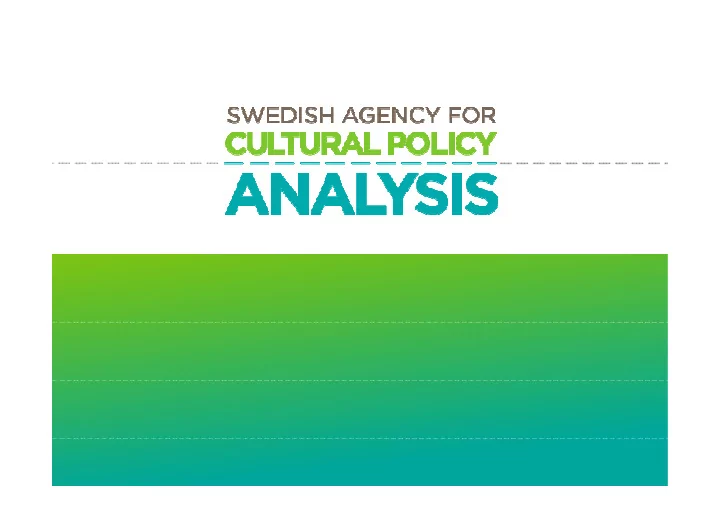

ESSNET FRAMEWORK FOR CULTURAL STATISTICS The ESSnet framework for cultural statistics is universal in the sense that it is based on standardized classifications that is harmonised in most countries The framework for cultural statistics provides a consistent way of measuring one piece of the cultural social economic importance i.e. economic output of cultural industries during a given time period.
HOWEVER… The main objective for the Swedish Agency for Cultural Policy Analysis is: � based on national cultural policy objectives, assess, analyse and report the effects of proposals and measures implemented in the cultural sphere. The task also involves analysing trends both in this sphere and in other social areas important in cultural life. (taken from the agency’s instruction)
WHAT IS THE ROLE OF THE SWEDISH AGENCY FOR CULTURAL POLICY ANALYSIS? Our main objective is to evaluate effects of policy measures, planned and implemented, in the cultural sphere in relation to the national cultural policy objectives. We have to analyse to what extent the cultural policy objectives are fulfilled. That involves taking into considering more factors than economic performance in order to get the ”whole picture”.
WHAT IS MEASURED AND WHAT DO WE WANT TO MEASURE? Primary study objective Effects on culture/cultural field What Policy ESSnet measures that framework will affect measures cultural (partly) industries Effects on the economy A piece of the puzzle
TOTAL ECONOMIC VALUE Total economic value Use value Non-use value Direct use value Bequest value Indirect use value Altruistic value What ESSnet Framework Option value measures What we need to take into consideration
CHALLENGES IN MEASURING THE VALUE OF CULTURE Use value Non-use value Direct use values can Demands special Income statement partly be measured in methods, i.e. are not (flow per time unit) monetary flows, such captured by market as GDP prices Balance sheet Measuring indirect A question for the (the value of assets – use values is a scientific community and liabilities – at a question for the given time) scientific community
CULTURE AS A RESOURCE David Throsby has suggested that: just as ecosystems support the real economy, so are also the cultural systems – the networks of cultural relationships and institutions that permeate societies – essential to sustain economics activity; thus, for example, it can be argued that when cultural ’ecosystems’ function well, human productivity can be increased and economic growth can be enhanced. - David Throsby (2005), ”On the sustainability of cultural capital”
CULTURE AS A RESOURCE From Throsby’s perspective the proposed methodology catches the inner circle for some sectors but not the importance of culture for economic development.
FINAL COMMENTS We are not saying that you should not use this framework. But you should be aware of what are the limitations in its explanatory power. What we are saying is that this provides only a part of the puzzle and to truly measure the dynamics of culture and economy other concepts needs to be considered as well. Such as: � The importance of culture as a ”production factor” in the economy. � The importance of culture on quality of life and well-being. However they are not that easy to measure.
Recommend
More recommend